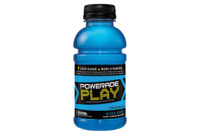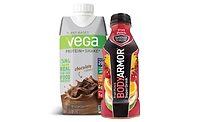Category Focus
Sports, protein drinks markets evolve beyond athletes
Everyday wellness the future for performance beverages

Image courtesy of Recover 180
When it comes to wellness, everyone has different habits that keep them going. In fact, a 2022 article by Dani Blum titled “The Little Rituals That Keep Us Going” delves into a selection of habits that people shared that helped them live life healthier and happier.
Consumers’ interest in wellness has impacted many beverage categories and the sports and protein drink markets are no different. What is different is these performance beverages were once synonymous with athletes, but instead have embraced the concept of supporting everyday wellness.
“[T]here is a shift toward marketing sports drinks and protein drinks for everyday wellness,” says Cara Rasch, food and beverage research analyst at Packaged Facts, a division of MarketResearch.com, Rockville, MD. “Sports drinks are now marketed as everyday ‘hydration multipliers’ for general well-being, not just for athletes. Unilever’s purchase of Liquid I.V. proves this ― the brand went from a sports drink to a daily wellness drink, driving category growth. Protein drinks are also targeting everyday use occasions for consumers to feel full for longer and have more energy throughout the day.”
Rasch explains that people are more likely to prioritize general wellness versus hardcore fitness, allowing sports and protein drink formulations to target “feel good” and “energized” throughout the day attributes to reach a broader audience.
“Casual users are a much larger present and potential market for these products than athletes and fitness enthusiasts,” she says.
Chicago-based Mintel also pinpoints the potential for sports and protein drinks beyond the traditional athlete consumer group. In its 2023 report titled “Sports and Performance Drinks – US” it notes how expanded functionality could allow brands to reach all consumer corners.
“Clustered consumer interest among non-athletes in additional functionality beyond sports performance proves the value in blurring beverage lines to expand relevance,” the report states. “The audience is there ― and willing to pay premium for these offerings.”
As the concept of everyday wellness permeates the industry, traditional sports drinks brands also are seeing opportunities in the hydration mixes segment.
For instance, this past fall, BODYARMOR Sports Nutrition, a division of The Coca-Cola Co., launched BODYARMOR Flash I.V. Hydration Boosters. The announcement came on the heels of the brand’s initial entrance into the rapid rehydration category with Flash I.V. ready to drink. This is BODYARMOR’s first foray into hydration boosters in single-serve powder stick form, it noted at the time of the release.
Packaged in compact single-serve, six-pack and 15-pack offerings, BODYARMOR Flash I.V. Hydration Boosters are available in five flavors ― Tropical Punch, Cucumber Lime, Grape, Strawberry Kiwi and Lemon Lime ― and feature more than 2,200 mg of essential electrolytes plus added functionality with zinc, vitamins B and C to support a healthy immune system, the company says.
Healthy hydration and children also have amalgamated with the rise of everyday wellness. Recently Mott’s, a brand of Keurig Dr Pepper (KDP), launched Mott’s Active, a new fruit-flavored hydrating juice beverage for active kids with naturally sourced electrolytes, no added sugars, and no artificial flavors. This is the first juice drink product from the Mott’s brand to offer hydration benefits via added electrolytes, it says.
Nearly 80% of households with children purchase sports drinks to hydrate, it says citing Circana data, and Mott’s Active provides a sports drink alternative in two juice flavors: Blastin’ Berry and Watermelon Burst, in a blend of apple juice and coconut water.
Yet, the aspect of everyday wellness expands beyond new product releases. Brand owners also are applying those principles to their partnerships.

For example, POWERADE, a brand of The Coca-Cola Co., announced a new partnership with Girls Inc., a nonprofit organization dedicated to inspiring girls to be strong, smart and bold. Together, POWERADE and Girls Inc. are teaming up to help young women reach their full potential through physical activity, mental resilience, and overall well-being. This collaboration represents POWERADE’s commitment to supporting organizations that provide leadership development for girls and youth, it says.
To kick-off the partnership, Girls Inc. unveiled four inaugural “She’s Got More POWERADE Scholarship” recipients, who each received $10,000 for their academic accomplishments and for demonstrating athletic achievement throughout their high school careers, it says.
“POWERADE is a dynamic brand with a deep history in sports and we’re proud to partner with Girls Inc. in an effort to champion the power of sports and the positive impact it has in the long term,” said Tom Gargiulo, BODYARMOR Sports Nutrition chief marketing officer, in a statement. “We are strong believers that sports can help instill confidence, resilience, and leadership skills. Together with Girls Inc., we hope to equip young girls with the tools they need to reach their full potential.”
Positioned for success
The performance beverage markets’ dedication to broader consumer needs has lifted its own performance.
“Sports drinks and the category of protein drinks, nutritional shakes, and meal replacement beverages performed well in the last year,” Packaged Facts’ Rasch says. “Packaged Facts has found that retail sales of sports drinks grew 9% in 2023, while sales in the category of protein drinks, nutritional shakes, and meal replacement beverages increased 6% during that time, compared to growth of 8.1% in the overall functional beverage market.”
Rasch predicts the category will continue to see growth, albeit at a decelerated pace.
“I expect these markets will continue to see growth in 2024,” she says. “Inflationary pressures greatly increased prices in the last few years at a time when volumes were also increasing, leading to an elevated base of sales. In 2024, sales are expected to grow off this elevated base at a slightly decelerated rate compared to 2023 as price inflation calms and volumes continue to increase.”
In Mintel’s report, the market research firm notes that despite budget restraints, the sports and performance drinks market still is a priority of consumers as 32% of surveyed consumers reported more frequent consumption compared with the previous year. Though inflation still will leave its impact on the category.
“Inflation will push sales up until intensity lessens and category sales resume more modest but consistent growth, especially as marketing parameters continue to widen to more consumers through layered functionality and inclusive marketing,” Mintel’s report states.

This all comes as the functionality and attributes of many beverage categories have taken on multiple roles. Case in point, the embracement of hybrid beverages.
“Functional beverages are increasingly blurring the lines between categories,” Packaged Facts’ Rasch says. “Products with multiple claims are on the rise. For example, sports drinks with caffeine offer both energy and hydration. We’re also seeing beverages with gut health benefits, immunity boosters, or weight management claims, all alongside traditional functions like sports recovery or hydration.”
Beyond functionality, Rasch explains additional health-and-wellness trends are likely to impact future formulations within sports and protein drinks.
“A number of trends are influencing and will continue to influence the market for sports drinks and protein drinks, including ‘better-for-you’ trends such as clean label, unrefined sugars, sugar-free and no sugar added claims, low-carb and high protein trends, and natural and organic ingredients, which will become increasingly available, and at lower price points, in the future,” she explains.
The younger generations such as Gen Z and Gen Alpha also are starting to shape the market more, yet everyday use occasions is the future the category, she adds.
“Protein is considered healthy by many consumers, who may look to protein drinks to increase their protein intake and stay full throughout the day without necessarily looking for functions such as sports recovery, bulking up, weight loss or meal replacements,” Rasch says. “Sports drinks will also continue to be sought out by consumers who are placing more attention on everyday hydration, bringing these beverages to more homes and workplaces rather than gyms and sports fields.”
Looking for a reprint of this article?
From high-res PDFs to custom plaques, order your copy today!






